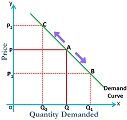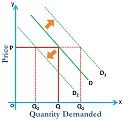 In economics, demand is defined as the quantity of a product or service, that a consumer is ready to buy at various prices, over a period. Demand Curve is a graph, indicating the quantity demanded by the consumer at different prices. The movement in demand curve occurs due to the change in the price of the commodity whereas the shift in demand curve is because of the change in one or more factors other than the price.
In economics, demand is defined as the quantity of a product or service, that a consumer is ready to buy at various prices, over a period. Demand Curve is a graph, indicating the quantity demanded by the consumer at different prices. The movement in demand curve occurs due to the change in the price of the commodity whereas the shift in demand curve is because of the change in one or more factors other than the price.
The demand curve is downward sloping from left to right, depicting an inverse relationship between the price of the product and quantity demanded.
Most of the economics student, find it difficult to understand the difference between movement and shift in the demand curve, so take a look at the article, and resolve all your confusions right away.
Content: Movement in Demand Curve Vs Shift in Demand Curve
Comparison Chart
Definition of Movement in Demand Curve
Movement along the demand curve depicts the change in both the factors i.e. the price and quantity demanded, from one point to another. Other things remain unchanged when there is a change in the quantity demanded due to the change in the price of the product or service, results in the movement of the demand curve. The movement along the curve can be in any of the two directions:
- Upward Movement: Indicates contraction of demand, in essence, a fall in demand is observed due to price rise.
- Downward Movement: It shows expansion in demand, i.e. demand for the product or service goes up because of the fall in prices.
Hence, more quantity of a good is demanded at low prices, while when the prices are high, the demand tends to decrease.
Definition of Shift in Demand Curve
A shift in the demand curve displays changes in demand at each possible price, owing to change in one or more non-price determinants such as the price of related goods, income, taste & preferences and expectations of the consumer. Whenever there is a shift in the demand curve, there is a shift in the equilibrium point also. The demand curve shifts in any of the two sides:
- Rightward Shift: It represents an increase in demand, due to the favourable change in non-price variables, at the same price.
- Leftward Shift: This is an indicator of a decrease in demand when the price remains constant but owing to unfavourable changes in determinants other than price.
Key Differences Between Movement and Shift in Demand Curve
The points given below are noteworthy so far as the difference between movement and shift in demand curve is concerned:
- When the commodity experience change in both the quantity demanded and price, causing the curve to move in a specific direction, it is known as movement in demand curve. On the other hand, When, the price of the commodity remains constant but there is a change in quantity demanded due to some other factors, causing the curve to shift in a particular side, it is known as shift in demand curve.
- Movement in demand curve, occurs along the curve, whereas, the shift in demand curve changes its position due to the change in the original demand relationship.
- Movement along a demand curve takes place when the changes in quantity demanded are associated with the changes in the price of the commodity. On the contrary, a shift in demand curve occurs due to the changes in the determinants other than price i.e. things that determine buyer’s demand for a good rather than good’s price such as Income, Taste, Expectation, Population, Price of related goods, etc.
- Movement along demand curve is an indicator of overall change in the quantity demanded. As against this, a shift in the demand curve represents a change in the demand for the commodity.
- Movement of the demand curve can either be upward or downward, wherein the upward movement shows a contraction in demand, while downward movement shows expansion in demand. Unlike, shift in the demand curve, can either be rightward or leftward. A rightward shift in the demand curve shows an increase in the demand, whereas a leftward shift indicates a decrease in demand.
Video: Movement Vs Shift in Demand Curve
Figure
Movement in Demand Curve
 Upward movement of the curve from A to C represents a contraction of demand due to the increase in the price of the commodity from P to P2. Downward movement of the curve from A to B denotes the expansion of demand due to the reduction in prices of the commodity from P to P1.
Upward movement of the curve from A to C represents a contraction of demand due to the increase in the price of the commodity from P to P2. Downward movement of the curve from A to B denotes the expansion of demand due to the reduction in prices of the commodity from P to P1.
Shift in Demand Curve
 Price remains unchanged, the rightward shift of the demand curve from D to D1 is termed as an increase in demand, as demand goes up from Q to Q1. The leftward shift of the demand curve from D to D2 is known as a decrease in demand, as demand goes down from Q to Q2.
Price remains unchanged, the rightward shift of the demand curve from D to D1 is termed as an increase in demand, as demand goes up from Q to Q1. The leftward shift of the demand curve from D to D2 is known as a decrease in demand, as demand goes down from Q to Q2.
Conclusion
Therefore, with the overall discussion, you might have understood, that a movement and shift in the demand curve are two different changes. Movement in the curve is caused by the variables present on the axis, i.e. price and quantity demanded. On the flip side, a shift in the curve is because of the factors which are other than those present on the axis, such as competitors price, taste, expectations and so on.








yandile says
what a nice expressed topic
it is so easy in that our SA learners could be able to understand it and know how to show it graphically as well to know it when is graphically shown.
Akua Antwiwaa Aboagye says
It’s very helpful.
I really understood it
Mainly Econ says
Fantastic! You have a post with great clarity.
Truly motivating.
Thanks for sharing.
Archibald M Dean says
Splendid presentation and analysis
Siddhesh patil says
Best explanation
Pujitha says
you have well explained about movement in the demand curve can you explain about movement in the supply curve on your YouTube channel
Kelvin Wangati says
It’s so helpful to me
Khushi says
much better to all source